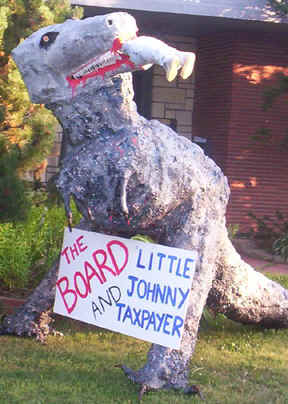


Do you know some place where we could put our return envelopes
for supporters to mail back donations?
Tell us where and we'll deliver them.
Donations online are no longer being processed.
|
|
|
12-30-2001 Superior has had easier time with schools
BY STEVE KUCHERA
The Superior school district has had a fair amount of experience closing schools over the past 20-some years. But those circumstances were different than those the Duluth school district faces as it struggles to balance its budget. "The difference is we didn't look at school closings strictly from the point of view of budget reductions,'' said Ben Kanninen, Superior's superintendent from 1987 to 1998. "It was more about upgrading facilities and not so much about saving money, although it did save money.'' Declining enrollments played a part in the closures of aging buildings. In 1971, the district had about 8,200 students. By 1982, it had about 5,800. Today it has about 5,050. In 1980, the Superior school district had 12 elementaries, two junior highs and a senior high school. Since then, the district has closed eight schools and will likely close another five. It's replaced them with four schools it built and two under construction. The result is that in two years -- after Northern Lights Elementary and the new middle school open -- the district will probably have only eight schools. Superintendent Jay Mitchell said it wasn't difficult for the School Board to decide which schools to close. "These were old, inefficient buildings,'' he said. "Once you take these schools out of there, the oldest school in the district will be the high school, which is only 36 years old.'' It's taken years of work, reports, referendum attempts and setbacks for the district to arrive at this point. In February 1979, for example, a district report recommended closing four elementary schools by 1983, building a new school and expanding another. The report also recommended closing Central junior high and Lincoln elementary by 1990 and building a new junior high and a new elementary school. But other than closing the 42-year-old Itasca Elementary in 1981, the district didn't act until after a 1983 citizens advisory committee again studied how best to use the district schools. In 1984, construction began on Four Corners and Lake Superior elementary schools. The two replaced Patzau, Washington, Nemadji and Franklin schools. The changes, of course, didn't please everyone. Under public pressure to keep Ericsson School open, the board delayed acting on a 1984 recommendation to demolish the school. The district studied alternative uses for the building, including using it as a magnet, before voting in August 1986 to close the school at the end of the 1986-87 school year. Earlier, a 1978 decision to move third-graders a mile to Franklin school from the Itasca school made some parents unhappy. And in 1981, more than 100 people attended a School Board meeting to plead that Itasca be kept open. Louis Thompson, who has been with the school district since 1950 as a teacher, a principal, an assistant superintendent -- and 15 years as a School Board member -- said closing Itasca was the most controversial decision he remembers. "You can never please everybody,'' he said. "But you try to do as much as possible. You try to involve all those who want to be in the debate. They need to know what the options are. You try to get a consensus if you can.'' Involving residents is essential to reducing controversy, said past and present school officials and school plan advocates. "It's important the public has input,'' Brad Theien said. "They need to know it's their plan and they had mountains of opportunity to have input into it.'' Theien was co-chairman of the 15-member Citizens Task Force for Facilities and Program Planning during the late 1980s and early 1990s. To educate the district's residents about the state of the schools and to get their input, the group held a series of public meetings. "I think we did about 60 different presentations, so we could plan for the future,'' Theien said. Despite the effort, the district's next planned step in replacing aging buildings met with defeat in September 1990, when voters rejected a $22 million bond referendum 53.5 percent to 46.5 percent. The money would have helped expand Superior Senior High School and build two middle and two elementary schools. The following February, the district put forth a stripped-down $16 million plan -- dropping the two elementary schools -- but voters rejected the idea two to one. Later in 1991, school officials announced a series of meetings throughout the district to get people involved in developing a new long-range building improvement plan. In March 1992, the board began discussing which buildings to replace. The discussion led to the construction and 1995 opening of Great Lakes, and a new Bryant elementary opened, replacing the old Bryant, Lincoln and Nelson Dewey. The last became home to Northland Secondary. Kanninen was superintendent when the district built Great Lakes and the new Bryant. "Nobody is ever happy entirely with change,'' he said. "But the idea that new facilities were needed was pretty well accepted. The conflicts were over maybe where new facilities should go and how boundaries to accommodate new attendance areas should be made.'' In 1994, as construction proceeded on the new Bryant and Great Lakes, the School Board began drawing up new boundary lines between elementary schools. One idea of moving students from Pattison to the new Bryant met with parental resistance. "We were concerned with what the School Board was going to do about a report from a citizens committee on shuffling kids around,'' said Dennis Peterson, one of those opposing the idea. "They were concerned about overcrowding. We told the School Board that the committee had gone beyond where they needed to go.'' "The School Board listened to what we had to say and recognized there wasn't a need to go as far as the committee had suggested,'' he said. "I think they have been pretty reasonable to a large extent,'' Peterson said of the School Board's decisions over the years. "I think they've done fairly well.'' Citizen involvement in district decisions continued in the late 1990s, as a 28-member citizen committee developed recommendations leading to November 1999's successful $47 million bond referendum. The referendum enabled the district to build Northern Lights Elementary and the new middle school and set the stage for the next round of school closings. The fact that the state is paying more than 70 percent of the referendum's cost is one reason it passed. The work of the committee's members was another, Mitchell says. The group offered tours of the schools now planned for closure and gave presentations on what schools in other districts offered that Superior did not. "We had to make the case for why those schools should be closed to vote 'yes' on the referendum,'' Mitchell said. "That must have worked with the tours.''
|
|